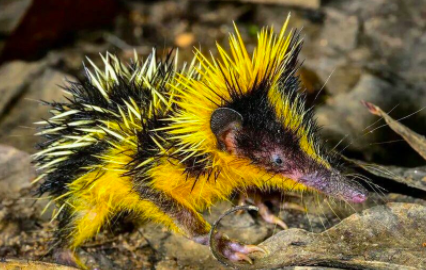The Wonders of Animals: Madagascar
One thing that I’ll never be bored of is learning new animal facts. There are just so many interesting creatures on earth that keep surprising me, and Madagascar is the best place for bizarre animal lovers.
As the fourth biggest island in the world, about the size of Texas, Madagascar is renowned for its rich biodiversity. It was separated from Africa about 160 million years ago, carrying off some species into long geographical isolation and resulting in a variety of endemic species. Due to paleoclimate shifts, some of these species in Madagascar were separated into smaller groups as they migrated into different elevations, thus more speciation occurred.
Based on the data, 70% of the estimated 250,000 species can be found only in Madagascar, and many of them share an odd look. Below are 5 animals that are less known than the common lemurs but are also native to Madagascar. See if you know any of them.
1. Satanic Leaf-Tailed Gecko
Find the gecko in five seconds. Go.
Name: Uroplatus phantasticus (flat-tail imaginary)
Size: 90mm (3.6 in)
Habitat: tropical forests
These nocturnal creatures sleep motionlessly on branches or among the leaves, and they’ll look like a dead leaf. Just like other geckos, they feed on insects such as crickets and moths.
The Satanic Leaf-tailed Gecko
The existence of the satanic leaf-tailed gecko is threatened by habitat destruction and the international pet trade.
2. Lowland Streaked Tenrec
Name: Hemicentetes semispinosus
Size: 140mm (5.5 in)
Habitat: tropical lowland rain forest
Lowland streaked tenrecs stamp their feet on the ground to increase earthworm activities, and poke their snout in the ground to find food. The keratinous quills located in their mid-dorsal region act as a communication device, either by raising them in agitation or by rubbing them together, known as stridulation.
The noise they make when rubbing these quills together is said to be too high for the human ears, but in this video, it kind of sounds like crickets. Tenrecs are the only mammals that communicate through stridulation.
3. Tomato Frogs
Name: Dyscophus antongilii (There are three species of “tomato frogs” so I just go with the reddest one)
Size: Females–10.5 cm (4.2 in); Males: 6.5 cm (2.6 in)
Habitat: lowland shallow pools, swamps, and slow-moving water
Tomato frogs’ bright orange-red color warns predators that they are toxic. They can also release a white secretion through their skin to deter predators. These substances can cause allergic reactions in humans, according to those who have eaten them.
Just because it’s called tomato frog doesn’t mean it’s edible…
There is still controversy on whether D. antongilii is a separate species or a variant of D. guineti, but the tomato frog is Near Threatened due to habitat degradation, pollution, and international pet trade (you can get one on petco.com). By the way, there is a population of tomato frogs in the Baltimore Zoo.
4. Madagascar Long-Eared Owl (a.k.a. Madagascar Owl)
Name: Asio madagascariensis
Size: 40-50 cm (16-20 in; females are larger than males)
Habitat: forests, but they seem quite adaptable and can live in degraded habitats
Just the opposite of penguins, the Madagascar Owl’s fur is white when it is young and turns brown as it matures. Like other owls, it is nocturnal and preys on mainly small mammals, including mouse lemurs.
5. Madame Berthe's Mouse Lemur
Name: Microcebus berthae
Size: 9.2 cm (3.6 in)
Habitat: Kirindy forest
This is the smallest primate in the world and is a result of the extensive speciation in Madagascar—there are so many species inside the genus Microcebus. Madame Berthe’s mouse lemur lives in the same region and shares a similar diet with the gray mouse lemur. However, their territory does not overlap as a result of competitive coexistence.
Madame Berthe’s mouse lemur is rated Critically Endangered by the IUCN Red List due to deforestation and habitat degradation. None of this species is kept in captivity and could become extinct in 10 years.
Work cited:
1.https://news.mongabay.com/2006/05/why-does-madagascar-have-so-many-unique-animals/
2.https://en.wikipedia.org/wiki/Uroplatus_phantasticus
3.https://en.wikipedia.org/wiki/Lowland_streaked_tenrec
4.https://web.archive.org/web/20090323165545/http://www.zoo.org/factsheets/tomato_frog/tomatoFrog.html
5.https://en.wikipedia.org/wiki/Madagascar_owl
6.https://en.wikipedia.org/wiki/Madame_Berthe%27s_mouse_lemur
Recommended Resources for More Fun Facts: Casual Geograph





